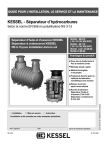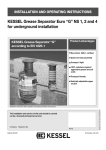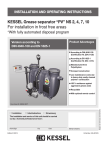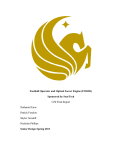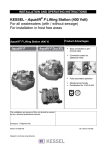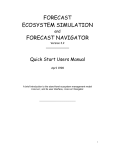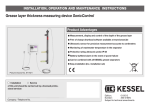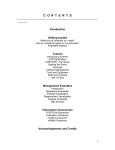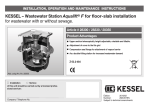Download KESSEL – Oil / Fuel separator KESSEL – Coalescence separator
Transcript
INSTALLATION AND OPERATING INSTRUCTIONS KESSEL – Oil / Fuel separator KESSEL – Coalescence separator PE Separators according to Euro-norm EN 858 NS 3-15 KESSEL – Oil / Fuel separator KESSEL – Coalescence separator According to EN 858 NG 3-15 for underground installation 99 403 - 99 615 (.10/.15/.30/.80) (B/D) 99 503 - 99 715 (.10/.15/.30/.80) (B/D) 99 703 (.04/.10) (B/D) 99706.10 (B/D Product advantages Easy on-site mobility without the need for heavy machinery Simple and quick installation and hook up Recyclable material Installation Commissioning Instruction The installation and service of this unit should be carried out by a licensed professional servicer Name Edition 2009/11 Date Town Company - Telephone No. Subject to technical amendment Seamless body due to monolith construction – 100% watertight ID number 010-619 1. Safety Instructions Personnel used for installation, assembly, operation, maintenance and repair must have the corresponding qualifications for such work. Areas of responsibility and the supervision of personnel must be clearly specified by the operator. The operating safety of the system supplied is only ensured in the event of proper use. The limit values specified in the technical data must not be exceeded under any circumstances. Accident prevention regulations and the applicable standards and directives must be observed at all times during installation, assembly, operation, maintenance and repair of the system! These include: • Accident prevention regulations - Construction work, BGV C22 - Waste water systems, GUV-V C5 • Safety regulations for work in enclosed areas of waste water systems, GUV-R 126 • Handling of biological materials in waste water systems, GUV-R 145 • Directives for work in tanks and restricted areas, BGR 117 • Standards - Construction pits and ditches - Embankments, shoring, working area widths, DIN 4124 - Laying and testing of waste water pipes and channels, DIN EN 1610 • Work aids for safety and health protection in waste water systems. ACCESS: NO SMOKING! Smoking is strictly prohibited near or around the separator at all times ! All sources of ignition or sparks are prohibited near or around the separator at all times ! SLIPPERY WHEN WET! Take caution when standing / walking near the separator. During disposal, cleaning and maintenance the surrounding area can become extremely slippery due to spilled oil / fuel. • Dangers from gases and vapours such as the danger of suffocation, poisoning or explosion • Danger of falling • Danger of drowning • Fecal pollution in waste water containing faeces • High physical and psychic stresses of work in deep, restricted or dark areas • and others Failure to observe these operating instructions may result in substantial material damage, physical injuries or fatal accidents. The system constitutes one component of an overall system. The operating instructions of the overall system and the individual components must therefore also be observed. During all assembly, maintenance, inspection and repair to any of the components, the overall system must be shut down and secured against restarting. Conversion or modifications to the system must only be made after consultation with the manufacturer. Original spare parts and accessories approved by the manufacturer must be used in order to ensure safety. The use of other parts may invalidate liability for the resulting consequences. 2 Table of Contents 1. Safety Instructions 2. General 3. Technical Data 4. Transport, Storage 5. Installation and assembly 6. Operation 7. Disposal 8. Maintenance 2.1 2.2 3.1 3.2 3.3 3.4 3.5 3.6 4.1 4.3 5.1 5.2 5.3 5.4 5.5 5.6 5.7 6.1 6.2 6.3 ................................................................................. Page Application................................................................ Page Separator description .............................................. Page 2 4 4 Installation example Oil-/Fuel Separator ........................... Dimensioned drawings Oil-/Fuel Separator ...................... Installation example Coalescence Separator ................. Dimensioned drawings Coalescence Separator................. Drawing Coalescence Separator Inspection Chamber LW 1000 ..... Dimensioned drawings Coalescence Separator Inspection Chamber LW 1000............................................... Page Page Page Page Page 6 6 7 7 8 Transport .................................................................. Page Storage..................................................................... Page Assembly requirements............................................ Filling Material .......................................................... Excavation pit........................................................... Tryouts before assembly ......................................... Assembly.................................................................. Alarm unit ................................................................. Oil and Sludge extraction ......................................... Page Page Page Page Page Page Page 9 9 Page 8 10 11 11 11 11 13 14 Making the plant ready for operation........................ Page 16 Commissioning / Instruction ..................................... Page 16 Important info ........................................................... Page 16 .............................................................................................. Page 16 .............................................................................................. Page 18 9. Accessories / Replacement parts .............................................................................................. Page 20 10. Warranty .............................................................................................. Page 21 12. Important contacts / info .............................................................................................. Page 23 11. Separator characteristics .............................................................................................. Page 22 3 Dear Customer, Before the KESSEL Oil / Fuel or Coalescence separator is installed and placed in operation please carefully read and follow all of the instructions contained in this Installation, Maintenance and User's Manual. Upon delivery of the KESSEL separator please thoroughly inspect the separator to make sure that it has not been damaged during shipping. In case damage has occurred to the separator, please follow the instructions listed in the, Guarantee section of this user's manual. 2. General 2. General 2.1 Area of application The separators are intended for use under specified conditions, see the Chapter “Installation and assembly”, for installation underground or below the foundation slab in well-ventilated areas. 2.1.1 Oil-fuel separators to Separator Class II The separators can be used: a) for the treatment of rainwater contaminated with light fluids from surfaced areas, e.g. filling stations, oil storage and handling areas, parking areas and streets in water protection areas b) as a retaining system for light fluids from systems and areas where light fluids are handled, e.g. filling stations, oil storage and handling areas c) for preliminary separation of light fluids from waste water before further treatment in subsequent internal waste water treatment plants. In cases a) and b), the discharged water from the separators is intended to be fed back into the public drainage system. If the discharged water is to be returned into waters, this is only possible in individual cases following clarification with the local water authority. In the treatment of dirty water contaminated with light fluids (commercial waste water) or waste water from the application areas of Appendix 49 of the waste water regulations, the observation of a limit value for hydrocarbons of 20 mg/l cannot be considered to have been observed. Separators for light fluids with coalescence device can be used: a) for the treatment of rainwater contaminated with light fluids from surfaced areas, e.g. filling stations, oil storage and handling areas, parking areas and streets in water protection areas, b) as a retaining system for light fluids for the safety of systems and areas where light fluids are handled, e.g. filling stations, oil storage and handling areas, c) for the treatment of dirty water contaminated with light fluids (commercial waste water) produced taking into account the operating conditions of industrial processes, the cleaning of parts contaminated with oil and the cleaning of floor areas contaminated with oil (except workshop floors), d) for the treatment of waste water produced taking into account the operating conditions of automatic vehicle cleaning (partial flow: outlet from the closed circuit into the drainage system), manual cleaning (vehicle washing, engine washing, underbody washing, chassis cleaning in washing bays, self-service or commercial washing bays except for the cleaning of workshop floors contaminated with oil) and for the drainage of areas used for the receipt, storage, drying, dismantling and crushing of old vehicles, e) for preliminary separation of light fluids from waste water before further treatment in subsequent internal waste water treatment plants. 2.1.2 Oil-fuel separators to Separator Class I 4 3. Installation 2.3 Functional description 햲 햸 햹 햶 햵 햴 햷 햺 햻 햳 In cases a) to d), the discharged water from the separators is intended to be fed back into the public drainage system. If the discharged water is to be returned into waters, this is only possible in individual cases following clarification with the local water authority. Separators used in case d) are used in systems for the restriction of hydrocarbons in waste water containing mineral oil in the sense of Part E Paragraph 2 of Appendix 49 of the waste water regulations. The level of hydrocarbons required by regulations in cases c) and d) of 20 mg/l is considered to have been observed. 2.2 System description The illustration shows a fuel separator cistern installed in the ground of Class A/B. Outlet point without stench trap Light fluid separator Inlet with stench trap Outlet with self-actuating closure Guide tube Float Attachment piece Cover Sample removal shaft Backwater valve 5 The separators separate light fluids and sludge out of the waste water by means of gravity. Light fluids refers to fluids of mineral origin with a density of ≤ 0.95 g/cm3, which are insoluble or only slightly soluble in water, and which are nonsaponifiable. These do not include stable emulsions, fats and oils of vegetable or animal origin. Light fluids float up in the separation chamber and collect at the surface. Sludges, which are heavier than water, sink to the bottom and form a sludge layer. Coalescence separators, like oil-fuel separators, work on the principle of gravity. To increase the separation performance, the tank also contains a coalescence insert. This cylindrical insert has two functions. Firstly, it affects the flow in the separator, and secondly it “filters” all the waste water through the coalescence material. When waste water containing oil flows through this filter fabric, very fine oil droplets that can no longer be separated out by gravity collect on the coalescence material, and combine to form large oil droplets. When these reach a sufficient size to create buoyancy, they detach themselves from the filter material and rise to the surface. Light fluid separators are equipped as standard with a selfactuating closure. When the maximum oil storage volume is exceeded, this device closes the outlet into the drainage system. This prevents the escape of light fluids into the drainage system. This safety device consists of a guide tube full of water, which houses a float. The float is carefully designed with regard to its weight, so that it floats in water, and sinks in light fluid (up to a density of 0.95 g/cm3). When the maximum oil storage quantity is reached, oil flows through the lateral openings into the float guide tube. The float then sinks, reliably shutting off the outlet of the separator. The self-actuating closure of a separator is an “emergency closure valve”. When actuated in an emergency, the separator must be taken out of service and maintained. 3. Installation 3.1 Installation example: KESSEL Oil / Fuel Separator Illustration shows KESSEL-oil-/fuel separator class II with cover class B and sampling chamber. 3.2 Dimensioned drawing DN 150: T-TEÜ = 155 mm DN 200: T-TEÜ = 180 mm T-TEÜ = Height above ground Class D: 700 mm ≤ TEÜ ≤ 1.500 mm Class A/B: 700 mm ≤ TEÜ ≤ 1.800 mm NS Sludge trap (l) Total Oil storage Overstand Weight (mm) volume (l) (l) (Kg) 1) Comparable total sludge trap volume according to dimensioning of DIN EN 858 2) Eccentric reduction of inlet/outlet to DN 150 possible on site, fitted through DN 150 sample removal shaft 6 Cover class Art No. 3. Installation 3.3 Installation example: KESSEL Coalescence separator Illustration shows KESSEL-coalescence separator class I with cover class B and sampling chamber. 3.4 Dimensioned drawing DN 150: T-TEÜ = 155 mm DN 200: T-TEÜ = 180 mm T-TEÜ = Height above ground Klasse D: 700 mm ≤ TEÜ ≤ 1.500 mm Klasse A/B: 700 mm ≤ TEÜ ≤ 1.800 mm NS Total Oil storage Overstand Weight (mm) volume (l) (l) (Kg) Sludge trap (l) 1) Comparable total sludge trap volume according to dimensioning of DIN EN 858 2) Eccentric reduction of inlet/outlet to DN 150 possible on site, fitted through DN 150 sample removal shaft 7 Cover class Art No. 3. Installation 3.5 Illustration: KESSEL coalescence separator shaft LW 1000, NS 3 NS Sludge trap (l) 3 3 3 3 800 800 1600 1600 Total Oil storage Overstand Weight (mm) volume (l) (l) (Kg) Ø 100 100 100 100 1100 Ø 1100 Ø 1100 Ø 1100 Ø 3.6 Dimension drawing of KESSEL coalescence separator shaft LW 1000, NS 3 545 995 1105 1055 545 995 1105 1055 545 995 1605 1555 545 995 1605 1555 790 790 1390 1390 200 200 200 200 110 110 110 110 175 205 190 220 Cover class Art No. B D B D 99703.04B 99703.04D 99703.10B 99703.10D 3.7 Dimensioned Drawing KESSEL-coalescence separator LW 1000, NS 6 (with upstream sludge trap) NS 6 6 Sludge trap (l) 1000 1000 Ø 150 150 1100 Ø 1100 Ø 560 1010 1090 1020 560 1010 1090 1020 Total Oil storage Overstand Weight (mm) volume (l) (l) (Kg) 1580 1580 200 200 110 110 8 305 338 Cover class B D Art No. 99706.10B 99706.10D 4. Transport and Storage Transportation of the KESSEL separator should be handled only by a transporter who has the proper knowledge, equipment and employees to handle such a product. During transport the separator must be firmly fixed into position and must not be allowed to move or shift in place. It also must be protected from other objects coming in contact with the separator during transport. If and when the separator is lifted it is important to follow the following correct procedures: The separator is not to be lifted with the use of steel cables or chains. Proper equipment are heavy duty cloth or hemp straps designed to handle the corresponding loads. The separator should be lifted by placing the proper straps beneath the inlet and outlet of the separator as seen in the illustration. Do not lift the separator by the small holes between the two manholes covers as illustrated on this page. In instances where a forklift is used, secure the separator to the forklift with appropriate cloth / hemp securing straps. Storage In cases where the separator needs to be temporarily stored before installation, it is important that the separator is placed on firm level ground and in an area where it is protected from coming in contact with other objects. Storing the separator outdoors will not cause any problems. 9 5. Installation and assembly During interim storage of the separator and up to the end of the installation work, suitable safety measures must be taken on the construction site to avoid accidents and damage to the light fluid separator. The Chapter Safety Instructions must be observed! edge of the lowest connected outlet. The necessary projection depends on the nominal size of the separator (see Chapter on Technical Data). If this excess height cannot be maintained, a warning device for light fluids must be installed. 5.1 Installation requirements The installation must be carried only by companies who have the necessary specialist experience, suitable equipment and adequately trained personnel for the task. The soil characteristics must be investigated for technical construction suitability (soil classification for technical construction purposes, DIN 18196). The maximum ground water level likely to occur must also be established. The ground water level must not exceed the level of the outlet. Adequate drainage of seepage water is also essential in the case of soils impermeable to water. The types of stresses occurring, such as maximum traffic loads and installation depth, must also be clarified. Drainage area Surface level covers Elevated area The separators for ground installation should be installed outside the building, as near as possible to the outlets. If necessary, the connection pipes of the inlets to the separator should be laid with heat insulation, or heated. The required frost-free installation depth is achieved by the use of telescopic attachment pieces, which also allows easy adjustment to feed and outlet pipes (drainage system). The covers for the load classes A / B and D are not bolted and comply with EN 124. Separator system ready for use Separator systems must be installed close to the point of origin of the light fluids. They must be easily accessible for cleaning and maintenance purposes. Light fluid separators must be protected against reverse flow from the drainage system. KESSEL recommend the following protective precautions: Illustration 1 The use of locked or ventilated covers is prohibited. Outlet point Separator Reverse flow protection Pump or lifting systems must not be installed in the supply line in front of the separator. If these are necessary, they must be installed after the separator. Inside a building Projection available No projection Reverse flow closure For the reliable operation of the system, KESSEL recommends the installation of a projection, and also a warning system. The necessary fitting requirements must be provided before filling of the construction pit. Outside a building Projection available No projection Reverse flow closure Inside a building Outside a building Separator systems must be installed so that the upper edge of the covers is sufficiently high in comparison to the made level of the surfaces to be drained (see Figure 1). The fluid level in the separator is always higher than the water level in the drainage system due to the difference in density between light fluid and water. The definitive level is the highest possible standing rainwater height, when dirty water and rainwater are channelled together. If only dirty water is being fed in, the definitive level is the upper 10 Reverse flow closure Lifting system 5. Installation and assembly 5.2 Filling material The separator must only be installed in non-cohesive or low-cohesive soils (Group G1 to G2 to ATV-DVWU - A127). Substrate: Round-particle gravel (max. particle size 8/16) to DIN 4226-1 Tank bed: Sand Tank jacketing: Round-particle gravel (max. particle size 8/16) to DIN 4226-1 Area outside tank jacketing: Material with suitable properties Covering layer: Humus or similar 5.3 Construction pit The foundation must be horizontal and level in order to be able to set up the system over the full surface, and must also afford adequate load-bearing capability. The substrate consists of compacted round-particle gravel (max. particle size 8/16, minimum depth 30 cm, Dpr=95%), covered by 3 - 10 cm of compacted sand. The spacing between the construction pit wall and the tank must be at least 70 cm. The embankments must be constructed to DIN 4124. The depth of the construction pit should be such that the limits of the earth covering are not exceeded. MIN ≤ TEÜ ≤ MAX (see dimension drawing in the Chapter on Technical Data). Root penetration In case of installation in the vicinity of trees or shrubbery, penetration by roots must be reliably prevented. Installation on a sloping site In case of installation of the separator on a sloping site, care must be taken to ensure that the laterally-acting soil pressure of unsecured soil is absorbed by a suitably dimensioned supporting wall. Frost-free depth for all-year-round use Always take care to observe the locally established frost-free depth when installing the separator. In order to ensure the smooth operation even in winter, the inlet and outlet pipes must also be laid at a frost-free depth during installation. 5.4 Tests before installation Immediately before installation of the tank in the construction pit, the responsible specialist of the company carrying out the installation must test and certify the following: - the integrity of the tank wall; - the proper condition of the construction pit, in particular with regard to the dimensions and substrate bedding; - the particle size of the filling material. 11 햶 햷 ≤ 20cm 햵 ≤ 30cm ≤ 30cm ≤ 30cm ≤ 30cm ≥ 50cm 햴 ≥ 50cm yyyyyyyyyy b nach DIN 4124 햲 ≥ 70cm 햳 햲 Subbase: round-grain gravel (max. graining 8/16) according to DIN 4226-1 compacted with Dpr=95% 햳 Tank bed: compacted sand 햴 Tank 햵 Tank encasing: round-grain gravel (max. graining 8/16) according to ≤ 30cm ≤ 30cm ≤ 30cm ≤ 30cm ≤ 30cm 3-10cm ≥ 30cm ≥ 70cm DIN 4226-1 compacted with Dpr=95% 햶 Area outside tank encasing: material of suitable consistence 햷 Top layer: topsoil, road surface, concrete or similar 5.5 Installation The float and coalescence insert, if fitted, remain in the tank during installation. Insertion The tanks must be placed carefully in the construction pit with the aid of suitable lifting equipment and positioned on the substrate bedding (see also the Chapter “Transport”). Filling of the tank and the backfilling construction pit In order to avoid deformation of the tank, the filling of the tank with water and the construction pit should take place in parallel. The tank jacketing should be applied to a width of at least 50 cm. The backfilling around the tank should take place in 30 cm incremental layers. Each layer should be compacted with light compaction devices (min. Dpr=95%). Damage to the tank wall and displacement of the tank during and after installation must be avoided. The self-actuating closure keeps the system closed during the complete filling process. Connection of the tank Any transport safety devices fitted must be removed. Note: the pipe connection fittings must be protected against damage in order to ensure the permanent integrity of the system. To make connection easier, the pipe connection fittings should be adequately greased. The transition from downpipes to horizontal pipes must be made using two 45° elbows separated by an intermediate pipe at least 250 mm long. A calming section must be installed in front of the separator system, which must be at least 10x as long as the nominal width of the feed pipe. 5. Installation and assembly When the construction pit has been filled and compacted to the lower edge of the feed and outlet connections, the feed and outlet pipes are laid frost-free and connected. Instructions for the warning system: Lay the connection cable or empty pipe during the earthworks. Insert the lip seal DN 600 in the groove in the dome Telescopic attachment Connection of the sample removal shaft. Sample removal devices must be installed in the direction of flow immediately after the separator. The sample removal device of the separator system must be freely accessible and positioned so that only waste water is removed which has passed through the separator. Connection of the warning system empty pipe, if applicable The connecting section between the separator and control unit must be kept as short as possible. Unnecessary changes of direction, in particular those with angles above 45°, should be avoided. The empty pipe for the cable should have a continual slope down to the separator. The formation of condensation within the empty pipe can be minimised by an airtight closure of the empty pipe on the side of the control unit. A cable pull-through wire can also be laid for subsequent cable laying. 7 6 5 3 1 (1) KESSEL light fluid separator (2) Layer thickness sensor (3) Reverse flow sensor (4) Control unit (5) Housing for wall installation 4 8 2 (6) Watertight cable connection (7) Attachment set (8) Empty pipe closure Lip seal DN 600 Minimum insertion depth 100 mm Tank dome and apply grease Insert the telescopic KESSEL upper section into the opening of the separator and adjust to the required position. With the aid of the clamping ring, the upper section can now be fixed in the required position (aligned with the upper ground level). The fine adjustment to the final height is then made with the aid of the setscrews. Slopes can easily be compensated for by the fully heightadjustable and inclining upper section. The upper section must be adequately supported from underneath and vibrated in using a flat-bed vibrator and a steel plate laid on the upper section. For greater installation depths, the special KESSEL intermediate piece (Art. no. 917402), height 400 mm, intended for this purpose should be used. remaining filling For installation in areas of heavy vehicle traffic (cover class D), a reinforced concrete slab must be provided as the upper layer. A corresponding formwork and reinforcement plan is available from KESSEL. 12 5. Installation and assembly 5.6 Warning system As specified by DIN EN 858, separator systems must be equipped with self-actuating warning devices. The KESSEL warning systems Art. no. 917801, 917802 and 917806 are alarm devices for light fluid separators (fuel, coalescence and oil separators). They are approved for operation in areas subject to the risk of explosion, Zone 0. KESSEL alarm system for oil layer monitoring (detection of the layer thickness in oil and light fluid separators) Oil layer probe suitable for Ex-Zone 0 with 5 m connection cable (extendible up to max. 200 m), attachment set for easy installation and maintenance (the probe is accessible from above), watertight cable connector for extension of the connection cable, through-pipe with screw closure and two screw-type cable connectors, housing for wall mounting IP 65, control unit with visual and acoustic alarm with potential-free contact, with sensor self-monitoring and alarm repetition. KESSEL alarm system for limit value display (detection of backing up in the light fluid separator) Limit value probe suitable for Ex-Zone 0 with 5 m connection cable (extendible up to max. 200 m), attachment set for easy installation and maintenance (the probe is accessible from above), watertight cable connector for extension of the connection cable, through-pipe with screw closure and two screw-type cable connectors, housing for wall mounting IP 65, control unit with visual and acoustic alarm with potential-free contact, with sensor self-monitoring and alarm repetition. The sensors of the warning system must be fitted at different height levels, depending on the size of the separator. The installation dimensions are shown in the table. The specified values must be checked during the course of regular maintenance, and corrected if necessary. 99403.10B 99403.10D 99610.15B 99610.15D 99606.30B 99606.30D 99610.30B 99610.30D 99606.80B 99606.80D 99610.80B 99610.80D 99615.80B 99615.80D 99703.04B 99703.04D 99703.10B 99703.10D Light fluid separator Art. No. Art. No. 99403.10BEX 99403.10DEX 99610.15BEX 99610.15DEX 99606.30BEX 99606.30DEX 99610.30BEX 99610.30DEX 99606.80BEX 99606.80DEX 99610.80BEX 99610.80DEX 99615.80BEX 99615.80DEX 99503.10B 99503.10D 99710.15B 99710.15D 99706.30B 99706.30D 99710.30B 99710.30D 99706.80B 99706.80D 99710.80B 99710.80D 99715.80B 99715.80D 13 The installation and maintenance of the warning system is described in the enclosed original operating instructions. Illustration of the cistern 100 mm 100 mm A B (*) 30° 30° 45° (*)Illustration of the oil layer probe 99503.10BEX 99503.10DEX 99710.15BEX 99710.15DEX 99706.30BEX 99706.30DEX 99710.30BEX 99710.30DEX 99706.80BEX 99706.80DEX 99710.80BEX 99710.80DEX 99715.80BEX 99715.80DEX Old probe New probe 113 mm Oil layer Alarm level Water Distance A of the limit value probe from the tank bottom Distance B of the oil layer probe from the tank bottom 1820 mm 1335 mm 1230 mm 1230 mm 1730 mm 1730 mm 764 mm 764 mm 1264 mm 1264 mm 1340 mm 835 mm 5. Installation and assembly Note: The holes for the attachment set must be drilled only at the specified positions. The holes must be made using a 3.5 mm diameter drill. The original attachment screws must be used in the attachment, without plugs. The positions of the holes should be adjusted accordingly if the seal might be damaged by the drill. Under no circumstances must the cone of the rotation tank be damaged or drilled through! The extension of the cable to max. 200 m is only possible using original parts (cable and cable connectors). Information can be obtained from the KESSEL Customer Service Department under telephone no. 0 18 05-27 82 82. The use of any parts other than KESSEL original parts will invalidate the ATEX approval, the construction type approval and any guarantee claims against KESSEL. When drawing in the cable into the empty pipe to the control unit, the cable screw connections on the empty pipe closure must be tightened firmly. The union nut must then be fixed to the end of the pipe. This is beneficial particularly for businesses with a high level of sludge. The complete separator can of course also be emptied by the sludge extraction device. If both devices are used for disposal, it must be ensured that the oil is disposed of first, followed by the sludge. The retaining device is attached at the inlet, using the pipe clamp as shown in the drawing. Fit the oil extraction to the retaining device, set to the required height x (see Table) and fix in position. Stub connection Sludge extraction Oil extraction Retaining device Sludge 1 2 Inner side 3 5 (1) Cables to the probes (2) Cable screw-fittings (3) Union nut (4) Through-seal 6 4 7 Outer side (5) Empty pipe closure (6) Through-pipe (7) Empty pipe 5.7 Oil and sludge extraction (for shaft LW 1000 on request only) For normal disposal, the hose from the suction vehicle is held in the light fluid separator and the complete contents pumped out. The volume of light fluid is however significantly less than the total volume of the separator. Assistance is provided in this case by the oil extraction device. For disposal of the light fluid, the suction hose is connected to the oil extraction device. The suction vehicle can then remove only the volume corresponding to the maximum light fluid quantity. This means a significant reduction of the disposal quantity, which together saves both time and disposal costs, and causes less wear to the separator components. In the same way as the oil extraction device, the disposal quantity can also be significantly reduced by the sludge extraction device. Fit the sludge extraction to the retaining device, feed to the bottom and then fix in position. Fit the stub connections to the attachment as shown in the drawing using the stainless steel screws provided. 14 5. Installation and assembly The holes must be made using a 3.5 mm diameter drill. Use the stub connection as a drilling template. Fit the knuckle coupling to the end of the hose and fix with a hose clamp. Hook the hose with the knuckle coupling upwards in the stub connection, lead to the extraction device and adjust to the required length. Connect the hose and extraction device and fix using a hose clamp. When the cover is closed, it must not be in contact with the knuckle coupling. Light fluid separator Art. No. 99403.10B 99403.10D 99610.15B 99610.15D 99606.30B 99606.30D 99610.30B 99610.30D 99606.80B 99606.80D 99610.80B 99610.80D 99615.80B 99615.80D 99703.04B 99703.04D 99703.10B 99703.10D 99403.10BEX 99403.10DEX 99610.15BEX 99610.15DEX 99606.30BEX 99606.30DEX 99610.30BEX 99610.30DEX 99606.80BEX 99606.80DEX 99610.80BEX 99610.80DEX 99615.80BEX 99615.80DEX 99503.10B 99503.10D 99710.15B 99710.15D 99706.30B 99706.30D 99710.30B 99710.30D 99706.80B 99706.80D 99710.80B 99710.80D 99715.80B 99715.80D 15 Distance X of the oil extraction from the tank bottom 99503.10BEX 99503.10DEX 99710.15BEX 99710.15DEX 99706.30BEX 99706.30DEX 99710.30BEX 99710.30DEX 99706.80BEX 99706.80DEX 99710.80BEX 99710.80DEX 99715.80BEX 99715.80DEX 950 mm 1450 mm On request 6. Commissioning The chapter "Safety instructions" must be heeded. 6.1 Setting up for operation Before the separator is put into operation, please make sure that: the separator is clean and the interior is free from any objects which may have been placed inside during shipping or installation. the separator is completely filled with clean cold water. Completely filling the separator is complete when water begins to drain from the outlet. 6.2 Initial Instructions Placing the separator into full operation is normally handled by a licensed tradesman although upon request can be handled by a KESSEL representative. The following personnel should be on hand when the initial instructions for placing the separator into operation are given: Building facilities manager Building maintenance workers Contracted plumber / tradesman Contracted disposal company What to do: Check to make sure the separator is completely watertight. Check to make sure that during transport and installation that no damage to the separator was caused. Check to make sure all connections to the separator (inlet, outlet, refill, rinse pipes etc.) are in perfect working order. Representative should discuss all necessary information regarding the disposal. Representative should take the customer step by step through all stages of a separator disposal. After the separator has been emptied (disposed) all necessary paperwork and documentation should be handed over to the customer. The separator should be returned to service by filling the separator with fresh, cold water. 6.4 Hand-over of installation and userʼs manual. 6.5 Completion of the commissioning report. After commissioning has been completed the separator should be placed into normal operation mode. 6.3 Commissioning report (see attachment) 7. Disposal Disposal intervals: The fuel / oil collected in the separator should be collected / disposed when the level has reached 80% of the maximum storage capacity. Disposal of collected sludge in the base of the separator should be collected / disposed when the level has reached 50% of the maximum sludge storage capacity. Important: Timely disposal of the separator is mandatory to insure proper function and operation of the separator. A licensed disposal company should be contracted to handle disposal of the separator. Disposal should take place when little or no wastewater is entering the separator. Emptying intervals: The light fluid retained in the separator must be removed at the latest when the quantity of separated light fluid reaches 80% of the maximum storage quantity, or the level is below the retained volume. For separators simultaneously or exclusively used for the drainage of systems or areas where light fluids are handled (e.g. fuelling areas), the retained volume required under state regulations must also be provided. The separated light fluid must also be removed at levels below this retained volume if the quantity of separated light fluids has not yet reached 80 % of the maximum storage quantity. The disposal of the sludge contained in the sludge trap must be removed at the latest when the separated sludge quantity reaches half of the sludge trap volume. Note: Light fluids and sludge must be removed as specified above in order to ensure the correct operation of the system. For this reason, a disposal contract should be concluded with a specialist disposal company. The disposal work should be carried out if possible when the system is not in operation. Expected disposal volumes in accordance with the filling level can be estimated by means of the following table. The figures contained in the table are approximate figures only for the purposes of estimating quantities when contracting a specialist disposal company. 16 7. Disposal Oil-/fuel Separator Art.-Nr.: 99403.10B 99403.10BEX 99503.10B 99503.10BEX 99403.10D 99403.10DEX 99503.10D 99503.10DEX 99610.15B 99610.15BEX 99710.15B 99710.15BEX 99610.15D 99610.15DEX 99710.15D 99710.15DEX 99606.30B 99606.30D 99610.30B 99610.30D 99606.80B 99606.80D 99610.80B 99610.80D 99615.80B 99615.80D 99703.04B 99703.04D 99606.30BEX 99606.30DEX 99610.30BEX 99610.30DEX 99606.80BEX 99606.80DEX 99610.80BEX 99610.80DEX 99615.80BEX 99615.80DEX 99706.30B 99706.30D 99710.30B 99710.30D 99706.80B 99706.80D 99710.80B 99710.80D 99715.80B 99715.80D 99706.30BEX 99706.30DEX 99710.30BEX 99710.30DEX 99706.80BEX 99706.80DEX 99710.80BEX 99710.80DEX 99715.80BEX 99715.80DEX 1) Filling level in % 50 40 30 20 10 50 40 30 20 10 50 40 30 20 10 50 40 30 20 10 Sludge Measured layer thickness in mm 650 530 430 330 210 650 550 450 340 220 1100 930 760 580 370 1100 910 740 560 350 Disposal volume in litres 1000 800 600 400 200 1500 1200 900 600 300 3000 2400 1800 1200 600 4000 3200 2400 1600 800 2) Filling level in % 100 80 60 40 20 100 80 60 40 20 100 80 60 40 20 100 80 60 40 20 Oil-/Fuel Measured layer thickness in mm 131 105 79 52 26 131 105 79 52 26 138 110 83 55 28 138 110 83 55 28 Disposal volume in litres 187 150 112 75 37 262 210 157 105 52 265 212 159 106 53 380 304 228 152 76 50 40 30 20 10 50 40 30 20 10 400 320 240 160 80 800 640 480 320 160 550 369 305 241 177 1050 815 587 369 241 100 80 60 40 20 100 80 60 40 20 235 188 141 94 47 235 188 141 94 47 200 160 120 80 40 200 160 120 80 40 99703.10B 99703.10D 99706.10B 99706.10D 50 40 30 20 10 400 320 240 160 80 1) The sludge retained in the separator must be disposed of at the latest at a filling level of 50%. 550 369 305 241 177 100 80 60 40 20 max. oil/fuel thickness 2) The light fluid retained in the separator must be disposed of at the latest at a filling level of 80%, or when the retained volume is exceeded. Water level max. sludge thickness 80% full, separator should be emptied 100% full, float switch closes 17 235 188 141 94 47 200 160 120 80 40 18 Specialist company monthly operating logbook Maintenance report Light fluid 80% is reached or the level is below the retained volume Sludge collection chamber is full The waste disposal regulations must be observed! Removal of light fluid and sludge Disposal company DISPOSAL Test report Before commissioning, then every 5 years Complete emptying Cleaning Check for proper condition and proper operation, and at least however: - Safety against the escape of light fluids from the separator system or the shaft units (excess height) - Structural condition and integrity of the separator system - Condition of the installed parts and the electrical equipment - Calibration of the self-actuating closure device - Completeness and plausibility of the records in the operating logbook - Disposal confirmations of the materials removed - Availability and completeness of the required approvals and documentation If the separator system is also used for the treatment of commercial waste water or waste water from the cleaning of vehicles, the following points must also be checked: - Actual volume of waste water (origin, quantity, contents, cleaning agents, operating materials, avoidable of stable emulsions) - Dimensioning, suitability and performance of the separator systems. Qualified body GENERAL INSPECTION * If the general inspection is carried out at shorter intervals than 5 years, the maintenance must be carried out by a specialist. Maintenance report 6-monthly · Emptying and cleaning, if necessary · Cleaning of the sample removal device · Check of the operating logbook MAINTENANCE Specialist company or works customer service 1 Measurement of the Measurement of the layer thickness of : layer thickness of : · light fluid · light fluid · of the sludge layer · of the sludge layer Check of the self-actuating Check of the self-actuating closure and warning device closure and warning device Specialist Docu- Installation certification operating logbook men- by specialist tation When What Who INSTALLATION SELF-CHECK operating logbook -As required Specialist company REPAIR 8. Maintenance and Controls 8. Maintenance and Controls The Chapter “Safety instructions” must be observed! 8.1 Maintenance The separator system must be maintained annually by a specialist 1). In addition to the removal of materials, the following work must also be carried out: - Check of the inner wall surfaces of the sludge trap and the grease separator, - Functional check of the electrical devices and installations, if fitted. - The findings and work carried out must be recorded in the operating logbook and evaluated. If fitted, electro-mechanical assemblies such as pumps, valves, shut-off devices etc. must be maintained twice yearly in accordance with the manufacturers’ instructions. 8.2 Checking (general inspection) Before commissioning, and then at regular intervals of no more than 5 years, the separator system must be completely emptied and cleaned, and then checked by a specialist 2) for proper condition and operation. The following points at least must be checked and recorded: - Assessment of the separator system - Structural condition and integrity of the separator system - Condition of the inner wall surfaces of the installed parts and the electrical equipment, if fitted - laying of the feed pipe of the separator system as a ventilation pipe over the roof - Completeness and plausibility of the records in the operating logbook - Confirmation of the proper disposal of the materials removed from the separator system - Availability and completeness of the required approvals and documentation (approvals, drainage plans, operating and maintenance instructions A checking report must be compiled on the checks performed, noting any existing faults. If faults are discovered, these must be rectified immediately.) General inspection of oil/coalescence separator Operating logbook of oil/coalescence separator Article 19 A “specialist” in this sense refers to personnel of the operator or other company, who by means of their training, skills and experience obtained from practical work, ensure that they carry out assessments or checks in the relevant specialised field to the required standard. 1) A specialist can acquire the specialist knowledge required for the operation and maintenance of separator systems in a training course with the following on-site instruction, which is offered for example by the corresponding manufacturers, professional trade associations, chambers of commerce and expert organisations in the field of separator technology. A “specialist” in this sense refers to personnel of business other than the operator, experts or other institutions which demonstrably have the specialist skills required for the operation, maintenance and checking of separator systems. In individual cases, such as larger operating units for example, these checks can also be carried out by internally independent specialists of the operator not bound by instructions with regard to their area of responsibility, who have equivalent qualifications and technical equipment. 2) Qualified bodies are specialist businesses independent of the operator or similar institutions, whose employees demonstrably have the specialist skills required for the operation, maintenance and checking of separator systems to the extent specified here, together with the technical equipment for the checking of separator systems. In individual cases, such as larger operating units for example, these checks can also be carried out by internally independent specialists of the operator not bound by instructions with regard to their area of responsibility, who have equivalent qualifications and technical equipment. 917 411/L 917 812 Order No. 9. Accessories / Replacement parts KESSEL alarm system set Oil/fuel level monitoring device (see Art. no. 917801) and back up / over flow monitoring device (see Art. no. 917802). Art.No. 917 806 KESSEL Oil / fuel level monitoring device. 5 meter connection cable (extendable up to 200 meter), installation set, watertight cable connection, conduit access insert, IP 54 control unit housing, plug in ready, with LED and audible alarm and potential free contact. Art.No. 917 801 KESSEL back up / overflow monitoring device. 5 meter connection cable (extendable up to 200 meters) installation set, watertight cable connection, conduit access insert, IP 54 control unit housing, plug in ready, with LED and audible alarm and potential free contact.. Art.No. 917 802 KESSEL alarm system cable for extension of the KESSEL oil layer probe and KESSEL limit value probe. Art.No. 917 810 KESSEL Oil Suction System Suction pipe B 50 with Bi 50 suction hose for on-site connection to interior of upper section, with Storz 52 C connection coupling. Inlet DN 150 DN 200 Art.No. 917 803 917 808 KESSEL Sludge Extraction System Suction pipe B 50 with sludge suction funnel, 0.5m re-enforced suction hose Bi 50 for on-site connection to interior of upper section, with Storz 52 C connection coupling.. Inlet Art.No. DN 200 917 809 DN 150 917 804 20 9. Accessories / Replacement parts KESSEL-Coalescence filter insert Art.No. 917 805 for KESSEL-Coalescence separator LW 1000 KESSEL-Coalescence filter replacement part Art.No. 917 816 10. Warranty 1. In the case that a KESSEL product is defective, KESSEL has the option of repairing or replacing the product. If the product remains defective after the second attempt to repair or replace the product or it is economically unfeasible to repair or replace the product, the customer has the right to cancel the order / contract or reduce payment accordingly. KESSEL must be notified immediately in writing of defects in a product. In the case that the defect is not visible or difficult to detect, KESSEL must be notified immediately in writing of the defect as soon as it is discovered. If the product is repaired or replaced, the newly repaired or replaced product shall receive a new warranty identical to that which the original (defective) product was granted. The term defective product refers only to the product or part needing repair or replacement and not necessarily to the entire product or unit. KESSEL products are warranted for a period of 24 month. This warranty period begins on the day the product is shipped form KESSEL to its customer. The warranty only applies to newly manufactured products. Additional information can be found in section 377 and 378 of the HGB. 21 In addition to the standard warranty, KESSEL AG offers an additional 20 year warranty on the polymer bodies of class I / II fuel separators, grease separators, inspection chambers, wastewater treatment systems and rainwater storage tanks. This additional warranty applies to the watertightness, usability and structural soundness of the product. A requirement of this additional warranty is that the product is properly installed and operated in accordance with the valid installation and user's manual as well as the corresponding norms / regulations. 2. Wear and tear on a product will not be considered a defect. Problems with products resulting from improper installation, handling or maintenance will also be considered a defect. Separator Characteristics Bahnhofstr. 31 D-85101 Lenting Type _____________________________________________________________________________________ Production number / production year_______________________________________________________________ Weight/kg_____________________________length x width X height____________________________________ EN ___ ________________________________________Approval______________________________________ ____________________________________________________________________________________________ Sludge trap volume / l _____________________________________Oil/fuel storage volume / l __________________ Control stamp___________________________________Material_______________________________________ (Accessories) ________________________________________________________________________________ This unit has been checked for watertightness to be sure that it is fully operational before leaving the factory. Date Name of examiner 22 Important contacts / Info Separator Type: __________________________________________________________ Day / Hour __________________________________________________________ Project description /Building services supervisor __________________________________________________________ Address __________________________________________________________ Builder __________________________________________________________ Telephone / Fax __________________________________________________________ Telephone / Fax __________________________________________________________ Address __________________________________________________________ Planner __________________________________________________________ Telephone / Fax __________________________________________________________ Address __________________________________________________________ Contracted plumbing company __________________________________________________________ Telephone / Fax __________________________________________________________ Address __________________________________________________________ KESSEL-Commissions no.: System operator /owner __________________________________________________________ Telephone / Fax __________________________________________________________ Address __________________________________________________________ User __________________________________________________________ Telephone / Fax __________________________________________________________ Address __________________________________________________________ Person of delivery __________________________________________________________ Other remarks __________________________________________________________ The system operator, and those responsible, were present during the commissioning of this system. ____________________________ Place and date ____________________________ Signature owner 23 ____________________________ Signature user Everything for drainage Backwater valves and cleanouts Grease separators Polymer and Ecocast drains Oil/fuel and coalescence separators Volatile liquid traps Inspection chambers Lifting stations, pumps, warning and control units Rainwater management systems Custom projects for industrial applications
























